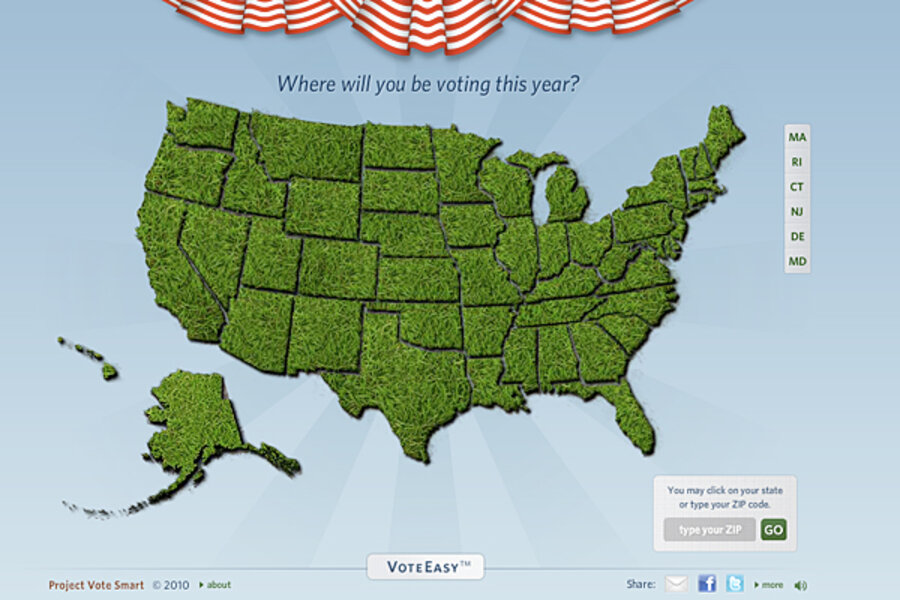Project Vote Smart unveils tool for the confused Election 2010 voter
Loading...
If this is the information age, why is it so hard to get basic answers about candidates running in Election 2010?
"Do you support United States military action in Afghanistan?"
"Do you support elimination of the federal estate tax?"
Fairly basic questions often left unanswered. But help is coming this week in the form of Project Vote Smart’s VoteEasy website.
The goal is to “keep it simple, dummy,” so the organizers have focused the site on congressional candidates' answers to the Vote Smart questionnaire, which asks basic questions, such as the ones above.
That allows the site to toss some interesting crumbs of information to the voter.
First, when you answer the same questionnaire put to the candidates themselves, the responses most like yours align themselves in real time with cool, little “yard sign” icons moving back and forth.
In other words, you can see which candidate thinks most like you in a glance. Then, presumably, being the conscientious citizen you are, once you narrow the field from say, 10 to two or three, you can click on through into the more sober research the site provides.
Project Vote Smart has been around since 1992 and has all kinds of bipartisan muscle behind it. Both former Democratic presidential candidate Michael Dukakis and possible 2012 Republican presidential aspirant Newt Gingrich sit on the board of the privately funded nonprofit.
In search of a straight answer
Despite these credentials, the group is finding it harder every election season to get candidates to go on the record with their positions, says board member Adelaide Elm.
She notes that when the Project first launched its questionnaire in 1992, the response rate was more than 60 percent. Now, she says, the percentage of candidates answering has sunk to 41 percent. She attributes this growing reluctance to go on the record to the increasingly divisive political environment.
“We are seeing the consultants for both parties telling their candidates in no uncertain terms: Stick to your talking points, do not answer any questionnaires,” she says.
The biggest reason, she adds, is that information on the Internet is forever. “Challengers can use position statements against incumbents in attack ads and consultants don’t want information about a wide range of positions so freely available to insurgents,” she adds.
To solve the problem of this information gap, the site falls back on what Ms. Elm calls “inferred” positions, based on voting records and public statements. The site gives the candidates a certain amount of time to answer the questionnaire, after which they will prepare inferred responses that they present to the candidates for a 48-hour review period. Then, they are posted if the candidate does not provide a personal response.
"This could be an impactful tool," Chris Dolan, a political scientist at Lebanon Valley College in Annville, Pa.
Problems with inferring
But the “inferred” positions may be problematic, says Jack Holmes, a political scientist at Hope College in Holland, Mich. Regardless of the reasons for the lack of transparency from candidates, inferred positions send a mixed message to voters.
“My concern is that when I looked up our local race for Congress, the Republican candidate's answers are inferred or left blank. It looks like one major candidate responded to them and the other did not,” he says via e-mail.
The sheer number of inquiries candidates receive is part of the problem, he adds. “If this is to be of real value, it needs to get beyond the status of just one more inquiry to the status of something that needs to be answered. When things are inferred, it does not raise my confidence in the endeavor.”
It is easy for the project to blame the candidates, he says, “but I think that the project needs to gain enough confidence to receive answers rather than make inferences, especially concerning major party candidates.”
The VoteEasy project has been under construction for nearly a year, says Kim Rees, a project designer at the firm Periscopic. It's official debut is Thursday, but it is already operational. But she adds, it is one more voter aid.
"What we were trying to do is help people get past that feeling of helplessness when that thick voter pamphlet arrives in the mail,” she says, adding, “This is just one more tool.”





